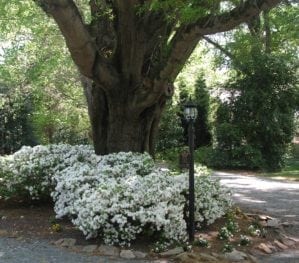GREEN AND GROWING
Cankerworm Update

Our big oaks need to be wrapped and unwrapped to protect them against cankerworm.
My friends in the various gardening circuits in which I orbit have all been asking the same question: What happened to the cankerworms? I observed almost no adult moths in my Tanglefoot® bands this year. Nor did I see or feel the little worms rappelling down their invisible threads and landing on my head and neck as I walked about this spring. Where did they go?
Assistant City Arborist Laurie Reid explains a possible reason why our hair and clothes are blissfully cankerworm-free this spring. “The cankerworm population, both this year and last year, have been very different from previous years. The caterpillars were late to emerge, and their numbers have been low,” While it is difficult to determine the exact reason, weather over the past two years might have disrupted their life cycle. The late frost in early 2017 affected the caterpillars by possibly killing leaves on trees, upon which the newly emerged caterpillars were feeding. With less food available, fewer caterpillars survived to pupate to a moth, which left fewer moths to emerge this past winter. Fewer emerging moths means a lower-than-usual number of eggs that could be laid, and, thus, a lower number of caterpillars this spring.”
Other experts have given me different theories, but all relate to the hard freeze in April 2017 or the heavy rains that followed. Whatever the reason, I am grateful.
I still see bands around trees. If you haven’t removed your tree bands, do so now. Leaving the band and batting up unnecessarily traps moisture and possibly wood destructive insects against the tree bark. Moisture can bring fungal infections and bugs, and they bring appetites. Since the bands are intended to trap cankerworm moths as they climb up the tree in March, they should all be taken down by April.
Tom Watson
Tom Watson is a Volunteer Extension Master Gardener in Mecklenburg County. He has also received a Certificate in Native Plants from UNC-C and a Certificate in Horticulture Technology--Residential Landscape Design from CPCC. He and his wife, Sue Bartlett, own The Cedars Davidson Bed & Breakfast.


